Physical Address
304 North Cardinal St.
Dorchester Center, MA 02124
Peritoneal cytology has an important role in the diagnosis and staging of abdominal and gynecologic neoplasms. Where peritoneal involvement by malignant tumors is extensive such as mesothelioma or high-grade abdominal or ovarian carcinomas, diagnosis can usually be confirmed by examination of ascites. However, additional procedures to assist diagnosis are required for localized tumors, less advanced disease, or follow-up of treatment. This may include examination of peritoneal washings, brushings, or smears.
A positive peritoneal washing for ovarian or fallopian tube carcinoma will upstage the diagnosis to an International Federation of Obstetricians and Gynecologists (FIGO) stage IC. The prognostic significance of malignant cells in washings or brushings varies, depending on the primary ovarian lesion, as for example in serous borderline tumor or serous papillary carcinoma. Adjuvant therapy for serous borderline tumors with positive peritoneal washings remains unproven. Positive washings obtained during “second-look” procedures at the end of a prescribed course of chemotherapy for ovarian carcinoma may indicate the need for continuation in therapy.
The presence of grossly evident peritoneal dissemination can be confirmed by histologic biopsy; therefore washings provide no additional information. However, the use of cytologic brushings or smears from liver or diaphragm may confirm extension of disease beyond the pelvis in patients without gross evidence of extraovarian spread.
Positive washing cytology may be associated with adnexal involvement of endometrial carcinoma. However, good therapeutic results can still be obtained as long as there is no clinical or pathologic evidence of lymph node involvement.
The significance of positive washings remains controversial for most types of uterine carcinoma, and staging for prognosis now requires histologic confirmation of serosal/adnexal involvement. If there is serous uterine carcinoma, evaluation of peritoneal washings is still required because of the risk of synchronous intraperitoneal neoplasia.
Malignant cells in washings are uncommon in patients with carcinoma of the cervix but, when identified, are associated with advanced disease and may require endocavitary chemotherapy to prevent recurrence. Laparoscopy and washing cytology have a role in the evaluation of upper abdominal malignancies.
Positive peritoneal washings are associated with peritoneal recurrence and poor prognosis in patients with gastric adenocarcinoma. Although a positive peritoneal washing on its own is sufficient to up-stage to metastatic disease, the prognosis is still better than when there is also gross peritoneal involvement.
In patients with potentially resectable pancreatic carcinoma, positive cytology is associated with more advanced disease.
The sampling procedure used can influence quantity and quality of cells obtained and therefore the diagnostic accuracy of the procedure.
Laparotomy , as the traditional method for obtaining cytologic material and staging of malignant neoplasms of the abdomen and pelvis, is very effective, provided an adequate surgical incision is made that allows systematic visualization and palpation of peritoneal and visceral surfaces. However, lesions involving recesses such as the cul-de-sac region or posterior diaphragm may still be overlooked. Smears from liver, diaphragm, and parietal surfaces can be used to provide additional information from these recessed locations.
Fiberoptic technology has revolutionized the use of laparoscopic/robotic procedures in gynecologic and surgical oncology. Laparoscopy is extensively used in the diagnosis of clinically benign pelvic disease such as endometriosis. The procedure involves the periumbilical insertion of a laparoscopic trocar through which diagnostic material is procured by way of fine needle, forceps cytologic brushing, or peritoneal lavage. Detailed examination of the celomic cavity is facilitated by the stretching of the peritoneal surfaces induced by gas insufflation, but effectiveness is limited if adhesions are present as is common with second-look procedures.
Implantable intraperitoneal chemotherapy port systems can be used as sampling devices to collect washings for detection of persistent intraperitoneal disease in ovarian carcinoma.
Tumor implantation at the laparoscopy site is uncommon but is more likely in patients with malignant effusion than in those with low-grade tumors without ascites. Dissemination of malignant cells via fallopian tube into the peritoneal cavity has been reported following hysteroscopy for patients with endometrial carcinoma.
The peritoneal cavity is normally completely lined by cuboidal mesothelial cells overlying a subserosal stroma well supplied by blood vessels and lymphatics. Detection of malignant tumor cells in washings and free fluid depends on exfoliation of cells and is influenced by such factors as extent of peritoneal involvement , localization by adhesion formation , and grade of tumor. Spread of malignant cells tends to occur by way of the vascular channels and lymphatics as well as across the peritoneal cavity, where deposits tend to lodge in dependent areas such as the cul-de-sac and paracolic gutters.
If there is no peritoneal involvement by tumor on gross inspection, any accumulated fluid should be aspirated and sent for cytologic evaluation. Otherwise, saline washings are submitted unfixed to the laboratory for processing as soon as possible; the specimen is well mixed, and an aliquot is resuspended in cytology fixative for preparation of cytocentrifuge or liquid-based preparations. Cytologic smears may also be prepared from surfaces such as the diaphragm, pelvic side wall, and solid viscera using a wooden spatula or cytobrush and spray fixed in 95% ethanol. The technique is convenient and cost-effective and enables a relatively large surface area of peritoneum to be sampled. Cell block preparations are useful in the workup of patients with suspicious lesions in cytocentrifuge or liquid-based preparations as they may provide optimal assessments of preserved architectural features and as a medium for multiple immunocytochemical staining procedures.
Peritoneal washings and brushings differ from effusions with respect to cellularity and composition such as the presence of detached sheets of mesothelial cells, which may give rise to problems in interpretation ( Fig. 12-1 ). The size of the sheets indicates that they are benign fragments of mesothelium. Flatness of the sheets, the orderly mosaicism of their cells, and the absence of nuclear features of malignancy are further indications of their benignity. The diagnosis of metastatic carcinoma in peritoneal washings, as with effusions, depends on identification of single cells and papillary cell groups showing obvious criteria for malignancy ( Fig. 12-2 ).
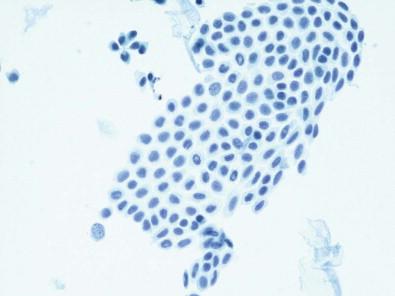
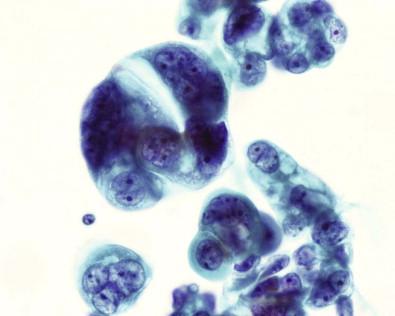
Review of histologic material from the primary tumor is very useful in evaluating peritoneal washings with abnormal cells. Cytohistologic correlation frequently assists in determining whether the cells are morphologically compatible with the primary lesion.
Mesothelial cells are usually readily recognized as uniform-appearing cells with bland nuclear chromatin, a normal nuclear to cytoplasmic (N : C) ratio, and sheet-like arrangements with intercellular fenestrations. Difficulties may arise in the interpretation of loose groups of cells with nuclear enlargement and nucleoli ( Fig. 12-3 ). Frequently, there is evidence of a transition to normal-appearing mesothelial cells.
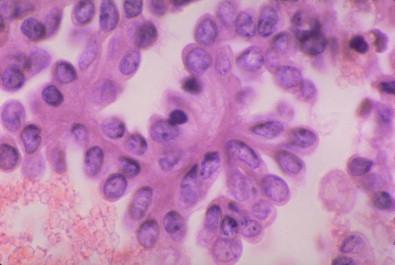
Cytologic atypia in mesothelial cells from peritoneal washings may be due to reactive changes associated with cyst or adnexal torsion , visceral adhesions , organizing hematoma , and inflammatory lesions such as pancreatitis and chronic salpingitis . Intraperitoneal chemotherapy may give rise to cytologic abnormalities that mimic malignancy.
Peritoneal washings from pelvic endometriosis may show loose clusters of atypical cells with decreased N : C ratios and prominent nucleoli. Characteristic hemosiderin-laden macrophages and spindle-shaped stromal cells may not always be present to assist diagnosis ( Fig. 12-4 ). Eosinophilic metaplastic change in endometriosis may also present as a diagnostic pitfall. Although well-differentiated endometrial adenocarcinoma has loose but usually 3-dimensional clusters of cells with coarse chromatin and nuclear membrane irregularities, the N : C ratio may not be increased if, as is sometimes the case, the cells have abundant cytoplasm. In endometriosis, however, the cells are low columnar with a bland nuclear chromatin and uniform nuclear membranes.
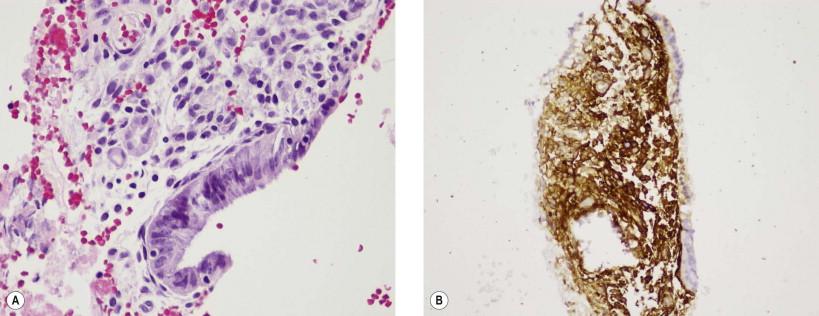
Rupture of ovarian or adnexal cysts often results in a distinctive cell population that can readily be differentiated from the surrounding mesothelial cells. Paratubal cysts have cohesive ciliated cuboidal cells that are recognizably benign. However, washings associated with ruptured endometriotic cysts may show considerable cytologic atypia and be difficult to differentiate from adenocarcinoma. Clinical correlation with reference to celioscopic and histologic findings may be necessary.
The other morphologic pattern that can give rise to significant diagnostic problems is the presence of papillary structures in peritoneal washings. Simple papillary structures are associated with Müllerian inclusions such as endosalpingiosis , frequently located on the peritoneal surface of the uterus, pelvic side wall, and cul-de-sac. These tightly cohesive tubular structures have a scanty layer of cuboidal or short columnar cells often arranged around psammoma bodies. The nuclear size is uniform with a vesicular chromatin pattern, and atypia is mild with small inconspicuous nucleoli.
These lesions need to be distinguished from well-differentiated papillary carcinoma or serous borderline tumors , which may show both simple and complex papillary groupings as well as occasional single cells. Complex papillary groups show cellularity with overlapping, increased N : C ratios, increased cell size, coarsening of the chromatin, irregular cell membranes, and prominent nucleoli ( Fig. 12-5 ).
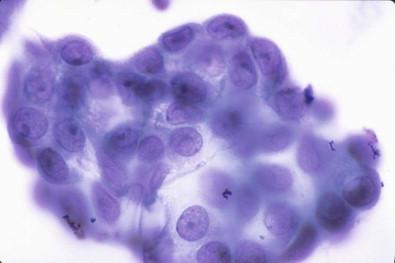
Complex papillary groups
Increased cell size
Overlapping nuclei
Irregular cell membranes
Prominent nucleoli.
Unusual findings may be seen in peritoneal washings or brushings obtained intraoperatively during cesarean section procedure. Incidental findings include gestational change in endosalpingiosis, peritoneal deciduosis, and well-differentiated papillary mesothelioma. It is important to obtain relevant clinical information and correlation with any lesions sampled histologically.
It is not uncommon for psammoma bodies to be identified in benign lesions such as adenofibromas or endosalpingiosis as well as serous papillary neoplasms. Therefore, the finding of psammoma bodies alone is not evidence of malignancy, even though it would indicate that further investigation is warranted.
Collagen balls (see Fig. 19.27 ) represent nonspecific entities which appear as globoid collagen balls or papillary clusters of mesothelial cells with collagen cores which may raise concern for papillary neoplasia.
The evaluation of ascitic fluid is concerned as much with identifying the site of origin as with confirming the presence of malignancy. The objective of peritoneal washings is to confirm malignancy; an abdominal/pelvic mass has already been identified. To that end, immunohistochemistry may assist in differentiating neoplastic cells from reactive mesothelial cells. Overinterpretation can be avoided if even a limited panel is used and correlation is made with the primary resected tumor. The panel could include conventional immunostains (BerEp4, LeuM-1, Calretinin, MOC-31, D2–40). In peritoneal washings of gastrointestinal and gynecologic cancers, molecular methods have potential to detect small quantities of residual disease not apparent by morphology alone. In situ hybridization techniques for detection of carcinoembryonic antigen (CEA) or human telomerase RNA components have potential for detection of small numbers of cancer cells from body fluids in patients with abdominal malignancies.
Peritoneal lavage cytology is a specific but a relatively insensitive procedure for detection of peritoneal surface involvement by malignant cells. To be useful, therefore, the cytologic findings should be evaluated in conjunction with clinical, serologic, and laparoscopic findings. The sensitivity of peritoneal cytology for detection of malignant cells varies from 48% to 88% for patients undergoing primary laparotomy for ovarian carcinoma, but is less for second-look procedures and histologically confirmed microscopic involvement in patients without gross peritoneal disease. This relates to reduced tumor burden or poor distribution of cells due to localization by adhesions. Separate collection of washing samples from multiple intra-abdominal sites does not appear to increase sensitivity either. Because brushings and smear specimens are usually obtained from a limited number of sites in the peritoneal cavity in patients without celioscopic evidence of tumor, the sensitivity of the technique is understandably low. Sensitivity of washing for gastric carcinoma is also low but use of adjunctive molecular techniques may help.
Sensitivity of peritoneal washing cytology for ovarian tumors of low malignant potential is high, and correlates with surface ovarian involvement and peritoneal implants. With that exception, ovarian carcinomas of high grade and stage were more likely to yield neoplastic cells in peritoneal washings than low-grade tumors.
A small but significant false-positive rate has been noted for cytologic washings in ovarian carcinoma, and several of the contributing factors have been discussed. Histologic correlation, preparation of cell block, and/or immunostains may help to reduce this discrepancy in peritoneal washings.
In some cases, it is possible that inadequate histologic sampling may account for what has been called erroneous false-positive results. Positive washings are infrequent in stage I endometrial carcinoma. Some of these results could be attributed to lymphatic spread or fallopian tube extravasation after endometrial biopsy procedures. Spread from lymphatics during hysterectomy procedures has been suggested as the reason for the presence of tumor cells only on postprocedure washings.
Fine-needle aspiration (FNA) cytologic evaluation of primary ovarian masses was introduced as a valuable diagnostic technique more than 20 years ago. Despite some initial skepticism as to its accuracy and efficacy, FNA is rapidly becoming the primary diagnostic and therapeutic maneuver for the evaluation of clinically and sonographically nonsuspicious cystic ovarian masses that persist in women of reproductive age. Other common indications for aspiration cytology include drainage of large cysts to permit laparoscopic removal of the cyst wall or ovary, avoidance of surgery in the pregnant patient, evaluation of ovarian tumors in patients with previously diagnosed and treated cancers, particularly when surgical options may be limited, and evaluation of a radiologically suspicious mass in patients who refuse or cannot tolerate surgical evaluation. The approach to complex or solid ovarian masses remains surgical in most instances.
Hesitation in the acceptance of ovarian cyst FNA centers on concerns regarding peritoneal seeding from tumor cell spillage, reliability of cytologic diagnoses, and redundancy of the procedure, as up to 75% of benign cysts will recur, ultimately requiring excision. Careful evaluation of clinical and ultrasonographic information should be applied to all cysts prior to aspiration, to limit or eliminate the risk of aspirating a malignant neoplasm, with the small but real possibility of peritoneal seeding. However, recent trends toward delayed childbearing have bolstered efforts to preserve ovarian tissue throughout the reproductive years. Additionally, some fertility drugs have been associated with an increased incidence of persistent follicle cysts. FNA drainage of cysts with cytologic evaluation of the fluid coupled with sclerotherapy to prevent recurrence may aid in preservation of fertility. This trend, combined with improvements in the technology of high-frequency sonography and increasing experience in the cytopathologic interpretation of ovarian cyst fluid, has led to broader acceptance and utilization of ovarian FNA.
Ovarian aspiration may be performed transvaginally, transrectally, transabdominally (via direct palpation or radiographically guided), laparoscopically, or directly at the time of laparotomy. Transrectal FNA is now used rarely, as a result of concerns regarding infection and the availability of other techniques. The transvaginal approach involves the insertion of a 14–22-gauge needle along a vaginal probe guided via real-time sonography. Strict sonographic criteria are used to identify cysts that can be drained safely in this manner. These criteria include size <10 cm; unilaterality; low echogenicity; absence of ascites; thin, regular walls in unilocular cysts, or thin, smooth septa in multinodular cysts; and no hypervascular foci on Doppler ultrasound. Cysts with low-level echogenicity, consistent with a hemorrhagic or endometriotic cyst, may also be included in patients with known or suspected endometriosis.
Intraoperative cytology (IOC) is a method of intraoperative consultation with the help of cytology smears or imprint specimens. Advantages of IOC are its simple, inexpensive, excellent preservation of cellular details, with no loss of tissue as occurs with cryostat sections and adequacy of surgical margins.
The ovaries are paired, ovoid organs that lie near the pelvic sidewall and lateral to the uterus. They are draped by a fold of the peritoneal mesothelium, with which the ovarian surface epithelium shares its embryologic lineage. The single or focally stratified layer of columnar to cuboidal surface epithelium that covers the ovaries may invaginate focally into ovarian stroma, resulting in the formation of epithelial inclusion cysts. Being of Müllerian derivation, the surface epithelium is capable of phenotypic alteration to resemble serous (tubal), mucinous (endocervical or goblet cell), endometrial, or transitional (urothelial) cells. Each cell type may be recapitulated in epithelial ovarian tumors.
The millions of ova present in the neonatal ovary dwindle in number throughout reproductive life, ultimately to be depleted by menopause. The developing ova are surrounded by a shell of granulosa cells that secrete estradiol (E 2 ) during folliculogenesis. The outer layers of the shell are composed of theca interna cells that produce a variety of hormones, including E 2 and androstenedione. After ovulation, the follicle-lining cells become luteinized, acquire abundant eosinophilic cytoplasm, and produce copious amounts of progesterone.
The ovarian stroma is largely composed of spindled cells that resemble fibroblasts, collagen, and various stromal cells with an enormous capacity for hormone and enzyme production.
Become a Clinical Tree membership for Full access and enjoy Unlimited articles
If you are a member. Log in here